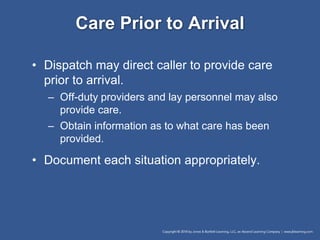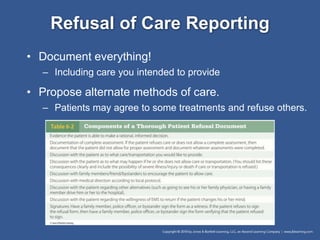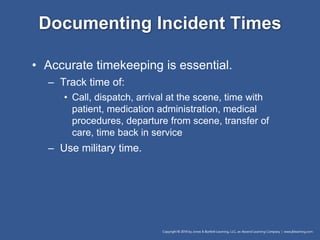Documentation
- 2. Preparatory Integrates comprehensive knowledge of EMS systems, the safety/well-being of the paramedic, and medical/legal and ethical issues, which is intended to improve the health of EMS personnel, patients, and the community. National EMS Education Standard Competencies
- 3. Documentation • Recording patient findings • Principles of medical documentation and report writing National EMS Education Standard Competencies
- 4. Introduction • EMS documentation is important. – Only written record of the call – Legal record – Becomes part of: • Patient’s medical record • Emergency department chart
- 5. Introduction • EMS professional needs to know: – What constitutes a report – What must be included – Who might read the report – When it must be completed – What terminology may be used
- 6. Introduction • For every call, the PCR should include: – Objective information (measurable signs) – Subjective information (patient’s symptoms) – Details of patient care
- 7. Introduction • PCRs must be complete, accurate, and legible. © Jones & Bartlett Learning.
- 8. Legal Implications of a PCR • Reports may include subjective statements from the patient. – Cannot include bias or personal opinions • Omissions and errors can result in: – Errors in care – Litigation – Job loss – Poor reputation
- 9. Legal Implications of a PCR • Reports should be: – Complete – Well written – Legible – Professional • Sloppy documentation implies sloppy care! • HIPAA has ramifications for patient care reporting.
- 10. Purposes of Documentation • The PCR is a record of: – The patient’s condition upon arrival – The care provided – Any changes in the patient’s condition – Condition on arrival at the hospital • Paints a picture of the scene and mechanism of injury or nature of illness
- 11. Minimum Requirements and Billing • To ensure timely billing: – Document procedures performed. – Obtain insurance codes. – Obtain medical necessity signature. – Document reason for ambulance transport.
- 12. EMS Research • Many states now require EMS agencies to submit data to their state EMS office. – Patient care data collection can improve EMS system as a whole. • NEMSIS stores standardized EMS data from each individual state. – The goal of NEMSIS is to define EMS care.
- 13. Incident Review and Quality Assurance • EMS reports may be requested for medical audits and other educational activities. – Run reviews – May be used to calculate number of times you performed a specific skill • Always accurately document skills attempted and performed with patient care.
- 14. Types of PCRs • Most EMS reports are electronic. – Can be easily shared between facilities, personnel, and databases – Improves continuity and efficiency of care – Advances evidence-based practice
- 15. Types of PCRs Courtesy of Rhonda Hunt. CourtesyofBryanWare. Courtesy of Jim Emerton
- 16. Types of PCRs • Many types of EMS report designs – Some services have developed check boxes and drop-down menus instead of narrative sections. • Regardless of the form, obtain the proper information.
- 17. Types of PCRs • Agencies are shifting away from paper PCRs. – Duplication of work – Can result in errors • Many electronic PCR options available • Computer-based PCRs should be NEMSIS compliant.
- 18. Documentation for Every EMS Call • Every call requires documentation. • Minimum data set – Standard items documented on every call • Run data • Patient data © Jones & Bartlett Learning.
- 19. Documentation for Every EMS Call • Run data – Incident times – Locations – Responding units/crew members • Patient data – Chief complaint – LOC/mental status – Vital signs – Demographics
- 20. Documentation for Every EMS Call • PCR should contain: – Objective observations of scene – Treatments – Effects of treatments – Changes in patient’s condition • Service treatments may be scheduled or unexpected.
- 21. Transfer of Care • Document in whose care you left the patient. – Avoids allegations of abandonment – Some agencies require nurse or physician signatures. – Required when you transfer a patient to another agency
- 22. Care Prior to Arrival • Dispatch may direct caller to provide care prior to arrival. – Off-duty providers and lay personnel may also provide care. – Obtain information as to what care has been provided. • Document each situation appropriately.
- 23. Refusal of Care Reporting • Competent adult patients have the right to refuse care. – Know and understand patient rights and state laws. • The patient should know: – His or her current situation – Right to receive and refuse care – Consequences of refusal of care
- 24. Refusal of Care Reporting • Patient must understand the consequences of refusing care • Information must be: – Given in a language the patient understands – Documented on the PCR – Witnessed by an observer – Initialed and signed by the patient
- 25. Refusal of Care Reporting • Unresponsive patients may be treated under implied consent. • Be familiar with individual state laws related to consent. • Confirm every effort is made to ensure patient’s best interests.
- 26. Refusal of Care Reporting • If you disagree with a refusal, know the next steps. – Document all contacted parties on PCR. • You must have a witness to the refusal. • Evaluate the patient’s mental status. • Remind patient he or she can call EMS later.
- 27. Refusal of Care Reporting • Document everything! – Including care you intended to provide • Propose alternate methods of care. – Patients may agree to some treatments and refuse others.
- 28. Workplace Injuries and Illnesses • OSHA guidelines require workplace injuries to be logged. – Companies may require additional documentation. – Document precautions taken and protective gear worn. – Be familiar with state requirements.
- 29. Special Circumstances • Mass-casualty incident (MCI) – Be familiar with triage tags. • Occupational exposure reports – Used if barrier device fails – Know state requirements. • Abuse and neglect cases – Supply as much detail as possible. – Be objective. • Physician’s arrival – Physicians may have authority to interject when they arrive on scene.
- 30. Special Circumstances • Mutual aid services, including: – Helicopters – Specialized rescue teams • Unusual occurrences: – Restraining devices – Severe weather • Controlled substances – Paramedics are responsible for security and accountability. • Follow policy of medical director.
- 31. PCR Narrative • Narrative should be: – Detailed – Accurate and complete – Specific • Narrative section should document: – Consultations – Orders from medical control – Refusal situations
- 32. PCR Narrative • Many methods for narrative documentation exist. • Know your agency’s preferred method.
- 33. PCR Narrative • Chronological order – Story format from dispatch until call was completed © Jones & Bartlett Learning.
- 34. PCR Narrative • SOAP method – Subjective information, Objective information, Assessment, Plan for treatment – Documents various aspects of the patient care encounter © Jones & Bartlett Learning.
- 35. PCR Narrative • CHARTE method – Chief complaint, History, Assessment, Treatment (Rx), Transport, and Exceptions © Jones & Bartlett Learning.
- 36. PCR Narrative • Body systems/parts approach – A head-to-toe approach – May be difficult to apply to EMS • Use one reporting method consistently. – Proper grammar and spelling are essential. – Consider carrying a reference guide.
- 37. PCR Narrative • Include: – Pertinent negatives • Negative findings that indicate that a thorough examination and history were performed – Spoken accounts • Indicate who made the statement. • Use quotation marks around the exact statement.
- 38. Elements of a Properly Written Report • Information should be comprehensive and concise. – Complete all sections, even if not applicable to call. • Handwritten reports should be: – Legible – Written in ink – Neat and easy to read
- 39. Elements of a Properly Written Report • Place reports in a secure location. • Complete in a timely manner. – Set aside time to complete documentation. • A written record should be left with the patient. – “Drop report” or “transfer reports” may used. – Follow state laws and requirements.
- 40. Elements of a Properly Written Report • PCRs should not contain: – Jargon – Slang – Personal opinions • Be sure your documentation is not libelous. – Only true and accurate statements – Use quotes
- 41. Elements of a Properly Written Report • Review your report before submitting it. – Completeness – Accuracy – Grammar and spelling – Medical terminology and abbreviations • Written reports reflect on the paramedic.
- 42. The Consequences of Poor Documentation • Inappropriate, inaccurate, and poor documentation can adversely affect patient care. • Legal implications – Poor reports may lead judge to decide for plaintiff • Affects paramedic’s reputation – Care provided may be questioned
- 43. The Consequences of Poor Documentation • Part of being a good paramedic is completing paperwork and reports. • Seek help if needed.
- 44. Errors and Falsification • If a revision must be made: – Note the date and time of revision. – Include purpose for correction. – Never discard the original. • Only the person who wrote the report can revise it.
- 45. Errors and Falsification • Follow protocol for making corrections. • The PCR is a legal document. © Jones & Bartlett Learning.
- 46. Errors and Falsification • Most electronic systems allow for amendments. • Addendums and supplemental narratives may be needed. – Follow your service’s policies. • Billing information may be needed. – Confidential – Follow laws and regulations
- 47. Errors and Falsification • Always be honest and thorough in your documentation. • Lost reports have huge legal implications. – Ensure reports are complete and turned in on time. – Do not keep copies of your reports.
- 48. Documenting Incident Times • Accurate timekeeping is essential. – Track time of: • Call, dispatch, arrival at the scene, time with patient, medication administration, medical procedures, departure from scene, transfer of care, time back in service – Use military time.















































